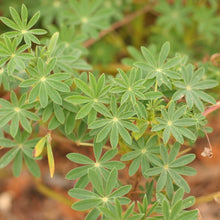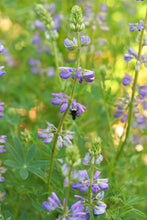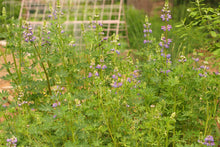Lupinus rivularis
Riverbank lupine, also known as streambank lupine, provides striking and long-blooming visual interest and a faintly pleasant scent. Its radially-compound leaves and whorls of light-purple pea-like flowers on vertical spires are an iconic sight in the Pacific Northwest. This species is fabulous in habitat gardens, growing quickly into a robust perennial or subshrub that produces pollen and nectar for humblebees, bumblebees, other native pollinators and beneficial insects. By fall, the flowers die back into spiraling seed capsules considered ornamental to some (like us!).
- Plant type/canopy layer: deciduous, perennial, herbaceous plant
- Size at maturity: 36- 48” tall, 24-36” wide
- Light requirements: full sun, part sun/part shade
- Moisture requirements: dry to moist soil
- Bloom time: March - August
- Growth rate/ease: fast growing, easy to grow
- Wildlife support: flowers attract and provide nectar to hummingbirds, adult butterflies, bees and other insect pollinators; overall plant attract and support beneficial and pest eating insects and is a caterpillar host plant and larval food source for native butterflies and moths
- Native habitat/range: grows in coastal habitats, meadows, and riverbanks west of the Cascades in southwestern Canada, Washington, Oregon and northwestern California. Portland Plant List - yes.
- Special features & uses: hummingbird and pollinator favorite; landscape uses include erosion control, nitrogen fixation, pollinator gardens, rock gardens, raingardens and meadowscapes
Gardening with Streambank Lupine: Many gardeners are less familiar with this species than its cousin, large-leaf lupine. The leaves and flowers of streambank lupine are visually very similar, just smaller, while the overall plant tends to be larger and branching in form, giving it an open, airy look. It also tolerates significantly drier soils, though deep and infrequent water in the summer months will prolong its blooms. It is exceptionally useful for erosion control as well as meadow restoration, with its nitrogen-fixing roots. The vegetation of this species can become quite woody and gnarled in the off-season. Many gardeners choose to cut it back in the fall or winter - however this will significantly diminish its habitat value. In Sparrowhawks garden, lupines that are front and center get cut back, while those in the foreground and backyard are left to live freely.
This species often behaves as a biennial: mostly vegetative the first year, with a few flowers, then displaying an impressive amount of blooms in the second year. It’s also notably short-lived, but can readily reseed itself in the garden. It provides us an exercise in not being too rigid about our landscape plan as it may go and come in different locations over many years. Nature has her own ideas and millions of years of experience.
Photo Credits: Karli Del Biondo, Beetles and Bees






